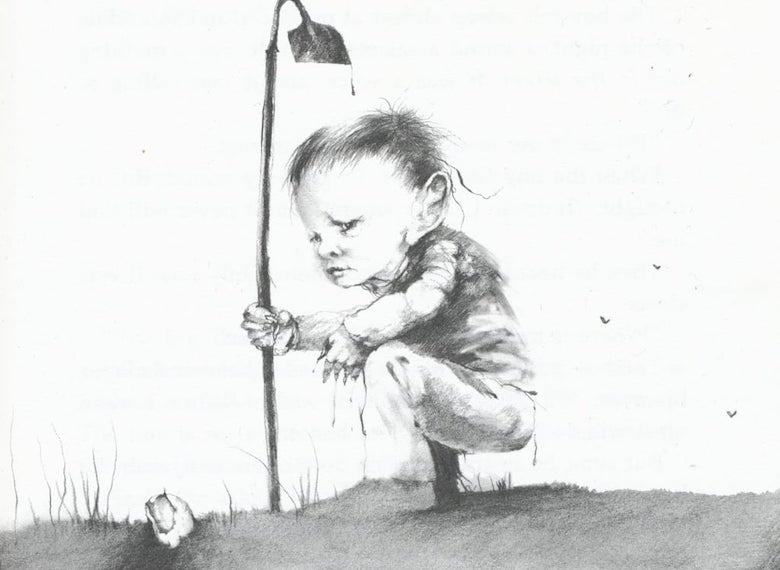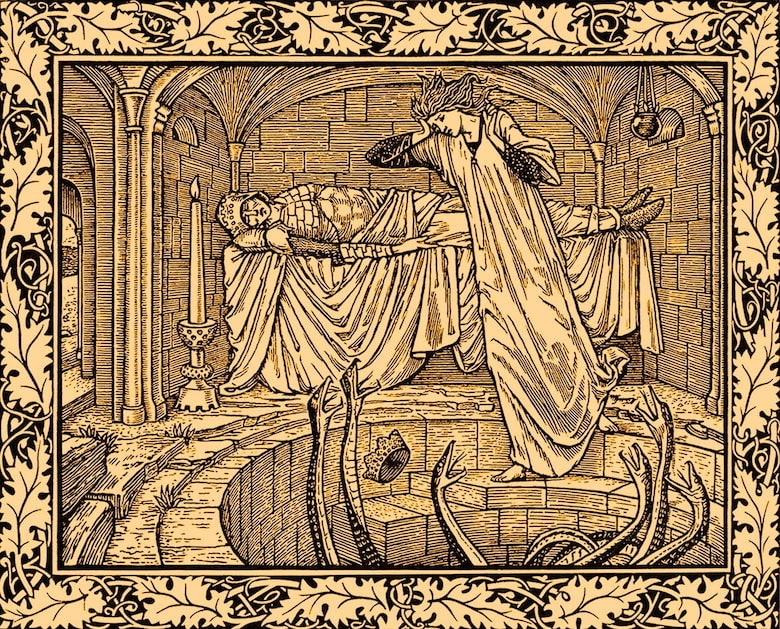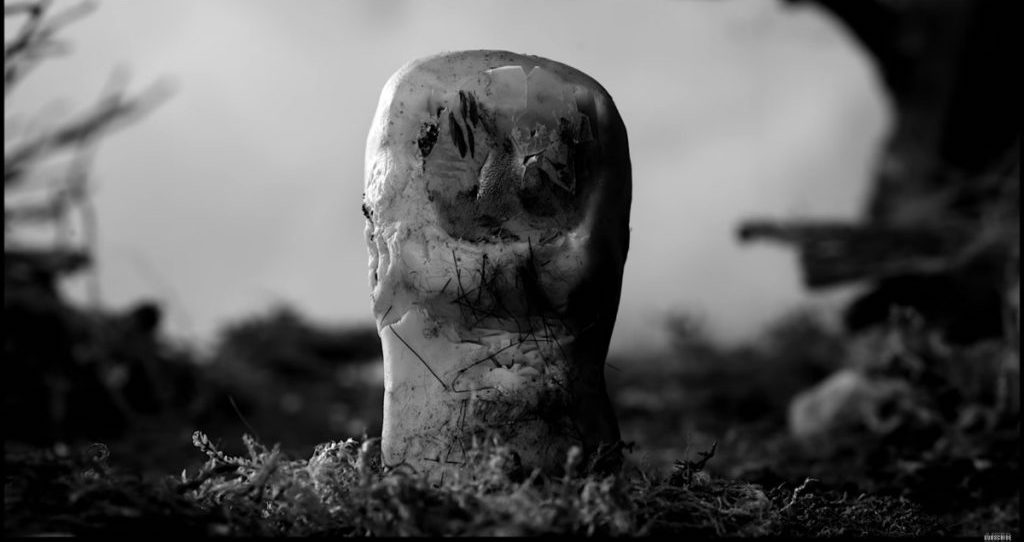I made a documentary about Scary Stories to Tell in the Dark. (Now available to watch.) The three books consisted of over 80 stories of folklore and urban legends. It was impossible to appropriately address each and every story in a single documentary. This website, in part, is a chance to look at individual stories that I researched, tales in which I learned about their origins and social contexts. It’s a chance to examine stories that I ultimately found to be fascinating in some way or another.
This is The Big Toe.
I’ve often cited “The Big Toe” as my favorite of the Scary Stories to Tell in the Dark tales. In some ways, it has become synonymous with what these tales are all about. It features a child as the protagonist, which being stories marketed and catering to children, had a certain harmony to it. It also is one of the most simple and in some ways “pure” of the stories that Alvin Schwartz chose to include in his collection.
It has a bit of childlike whimsy that encapsulates the stories in a way that few others do. It was chosen to be the very first story, and I think there is a reason Alvin Schwartz chose it as such.
But where does it come from? And what other versions and adaptations exist? Let’s crack this scary story and chew the fat a little as we dive deep into The Big Toe.
“The Big Toe” Scary Story in the Book
Here is the full version of the scary story “The Big Toe,” which happened to be the very first story in the first Scary Stories to Tell in the Dark books. The beginning decision to eat the toe is often cited as a bit silly and child-like, but in some ways connects it to many Grimms’ fairy tales and similar collections that involve cannibalism.
A boy was digging at the edge of the garden when he saw a big toe. He tried to pick it up, but it was stuck to something. So he gave it a good hard jerk, and it came off in his hand. Then he heard something groan and scamper away.
The boy took the toe into the kitchen and showed it to his mother. “It looks nice and plump,” she said. “I’ll put it in the soup, and we’ll have it for supper.” That night his father carved the toe into three pieces, and they each had a piece. Then they did the dishes, and when it got dark they went to bed.
The boy feel asleep almost at once. But in the middle of the night, a sound awakened him. It was something out in the street. It was a voice, and it was calling to him. “Where is my to-o-o-o-o-e?” it groaned. When the boy heard that, he got very scared. But he thought, “It doesn’t know where I am. It never will find me.” Then he heard the voice once more. Only now it was closer. “Where is my to-o-o-o-o-e?” it groaned. The boy pulled the blankets over his head and closed his eyes. “I’ll go to sleep,” he thought. “When I wake up it will be gone.”
But soon he heard the back door open, and again he heard the voice. “Where is my to-o-o-o-o-e?” it groaned. Then the boy heard footsteps move through the kitchen into the dining room, into the living room, into the front hall. Then slowly they climbed the stairs. Closer and closer they came. Soon they were in the upstairs hall. Now they were outside his door. “Where is my to-o-o-o-o-e?” the voice groaned. His door opened. Shaking with fear, he listened as the footsteps slowly moved through the dark toward his bed. Then they stopped. “Where is my to-o-o-o-o-e?” the voice groaned.
“YOU’VE GOT IT!”

Adaptations: From the Scary Stories Movie to Short Films
As many know, “The Big Toe” story was loosely adapted in the Scary Stories to Tell in the Dark movie, released in 2019.
The adaptation of the books tied several prominent stories into one single narrative. So it isn’t surprising that there were notable differences in order to do that. In this case, the beginning of the story is not depicted, so we only get the eating of the toe and the mysterious “owner” of the toe coming in to grab him. And while what this owner and what it looks like is not described in the story, the filmmakers used the illustration from the Haunted House as a stand-in for this zombie creature.
Short films are an opportunity to tell a story like “The Big Toe” in a more straightforward manner, not as part of a longer narrative. Perhaps one of the most successful examples of this is a short film from 2020 titled “The Big Toe,” directed by Neal O’Bryan and Chad Thurman and done in stop-motion animation.
One thing that has gone under the radar is that there was an anthology show based on Scary Stories to Tell in the Dark in 2012, originally titled Spooky Tales. Most of them can be found on Youtube. The below adaptation of “The Big Toe” is quite good.
Browsing on Youtube, you will find many other adaptations of this particular scary story. That is the great thing about folklore. It lives on in many different adaptations and tellings.
The Origins Behind “The Big Toe” Scary Story
As Alvin Schwartz wrote in his source materials, “The Big Toe” scary story is a “traditional story which is widespread in southern United States” and he notes how he learned this one in the U.S. Navy during World War II. His particular informant was a sailor from either Virginia or West Virginia. But what has become widely known at this point is that “The Big Toe” is a variation of what has become blanketly known as the “Golden Arm” stories.
— FOUNDATIONS OF HORROR —
Further explore these subgenres & tropes. more>>
#Scary Stories to Tell in the Dark | #Cannibal horror | #Folk horror | #Jump Scare | #Revenge is Sweet | #Zombie horror

Mark Twain famously described “The Golden Arm” as a great example of how to tell a story well. He went on a reading tour with George Washington Cable in 1884–1885 and during the tour he would feature ghost stories, using the story of The Golden Arm as his prime example. He then featured it in his How to Tell a Story and Other Essays.
Of course, The Golden Arm goes back much further and was told as an oral tale long before it began to be seen in print. Folktales are often categorized according to the Aarne–Thompson Index, and this one falls under Aarne–Thompson Type 366, which is a corpse coming back to life to reclaim something that is theirs.

You can find many other examples of such stories from many different regions and traditions here: A Corpse Claims Its Property.
The Meaning Behind “The Big Toe”
With tales so old and so engrained in human storytelling tradition, there are universal themes that are bound to be found from such stories. In the case of “The Big Toe,” scary stories point to innate fears of death and their repercussions. Children benefit from their parent’s death, through land and the resources they leave behind. Each generation benefits from the previous one. And so anxieties and second-guessing the natural order of things becomes a natural fear.
Someone dies and I get their land and property; I get my place in the world because the generations before me are dead and buried and not here anymore. It’s not fair, but it is part of life. So having the dead return with vengeance and a moral reason to get what they still have on this earth becomes a storytelling trope. Because it has deep psychological underpinnings.
It can allude to physical things such a toe or expensive arm (as stories usually do), but in the end that usually equates to our own personal demons and feelings about death and dying. Am I and my generation living up to the people who came before? Or am I guilty of robbing the dead in some fundamental way? That’s a true fear.
“The Big Toe” scary story is also notable for being one of many “jump scare” stories that are included in the Scary Stories to Tell in the Dark books, but as Mark Twain notes, this has a long tradition in storytelling. I discuss that more in other scary story examples such as Me Tie Doughty Walker.
Last Updated on June 14, 2022.

